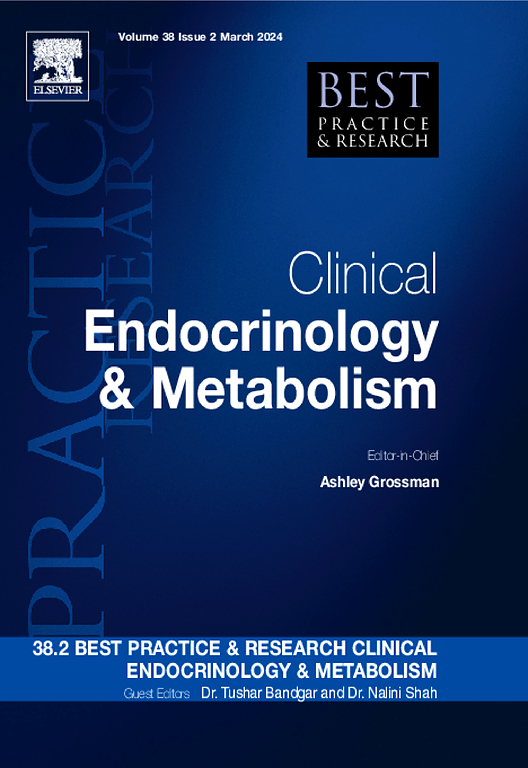Systemic therapy for patients with metastatic pheochromocytoma and paraganglioma
IF 6.1
1区 医学
Q1 ENDOCRINOLOGY & METABOLISM
Best practice & research. Clinical endocrinology & metabolism
Pub Date : 2025-01-01
DOI:10.1016/j.beem.2025.101977
引用次数: 0
Abstract
Pheochromocytomas and paragangliomas are rare neuroendocrine tumors derived from the paraganglia. These tumors frequently secrete excessive amounts of catecholamines leading to cardiovascular and gastrointestinal complications. While all pheochromocytomas and paragangliomas possess the potential for metastasis, actual metastatic occurrences are observed in approximately one third of cases. The metastases primarily affect the lymph nodes, skeletal system, liver, and lungs. Furthermore, patients often experience a reduced overall survival rate attributed to factors such as tumor size, disease advancement, and excessive catecholamine secretion. For several decades, treatment options for patients diagnosed with metastatic pheochromocytomas and paragangliomas have primarily included combination chemotherapy with cyclophosphamide, vincristine, and dacarbazine, along with Iodine-131-metaiodobenzylguanidine. However, significant advancements in scientific research over the past 25 years have enabled a comprehensive characterization of these tumors from biochemical, molecular, and diagnostic standpoints, resulting in the identification of new therapeutic alternatives for affected patients. In the last decade, we have witnessed the introduction of innovative systemic therapies specifically designed for those with metastatic pheochromocytomas and paragangliomas. In this review, we aim to present findings on the efficacy, safety, and overall activity from prospective clinical trials involving radiopharmaceuticals and tyrosine kinase inhibitors, and we will also outline the prospective advantages of additional novel therapies currently under evaluation.
转移性嗜铬细胞瘤和副神经节瘤的全身治疗。
嗜铬细胞瘤和副神经节瘤是罕见的起源于副神经节的神经内分泌肿瘤。这些肿瘤经常分泌过量的儿茶酚胺,导致心血管和胃肠道并发症。虽然所有嗜铬细胞瘤和副神经节瘤都有转移的可能,但在大约三分之一的病例中观察到实际的转移发生。转移主要影响淋巴结、骨骼系统、肝脏和肺部。此外,由于肿瘤大小、疾病进展和过量儿茶酚胺分泌等因素,患者经常经历总生存率降低。几十年来,诊断为转移性嗜铬细胞瘤和副神经节瘤的患者的治疗选择主要包括环磷酰胺、长春新碱和达卡巴嗪联合化疗,以及碘-131-甲氧十二苄基胍。然而,在过去的25年里,科学研究取得了重大进展,从生化、分子和诊断的角度对这些肿瘤进行了全面的表征,从而为受影响的患者确定了新的治疗方案。在过去的十年中,我们见证了专门为转移性嗜铬细胞瘤和副神经节瘤患者设计的创新全身疗法的引入。在这篇综述中,我们的目标是展示涉及放射性药物和酪氨酸激酶抑制剂的前瞻性临床试验的有效性、安全性和总体活性的研究结果,我们还将概述目前正在评估的其他新疗法的前瞻性优势。
本文章由计算机程序翻译,如有差异,请以英文原文为准。
求助全文
约1分钟内获得全文
求助全文
来源期刊
CiteScore
11.90
自引率
0.00%
发文量
77
审稿时长
6-12 weeks
期刊介绍:
Best Practice & Research Clinical Endocrinology & Metabolism is a serial publication that integrates the latest original research findings into evidence-based review articles. These articles aim to address key clinical issues related to diagnosis, treatment, and patient management.
Each issue adopts a problem-oriented approach, focusing on key questions and clearly outlining what is known while identifying areas for future research. Practical management strategies are described to facilitate application to individual patients. The series targets physicians in practice or training.

 求助内容:
求助内容: 应助结果提醒方式:
应助结果提醒方式:


